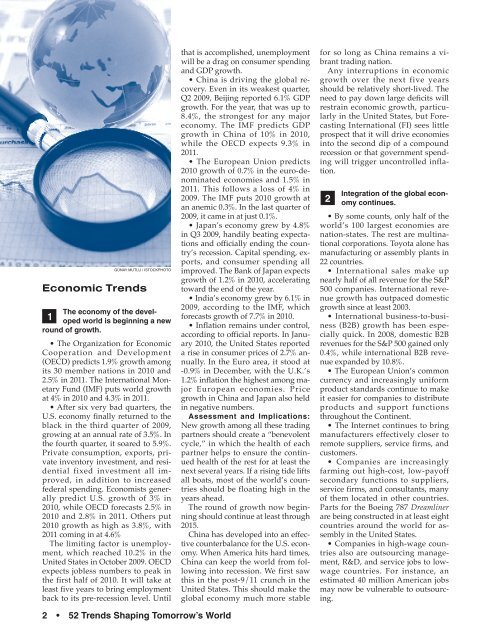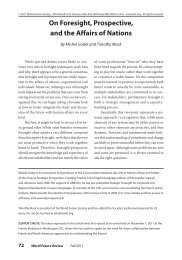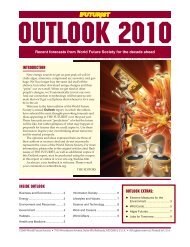Economic <strong>Trends</strong>■ 1The economy of the developedworld is beginning a newround of growth.GÜNAY MUTLU / ISTOCKPHOTO• The Organization for EconomicCooperation and Development(OECD) predicts 1.9% growth amongits 30 member nations in 2010 and2.5% in 2011. The International MonetaryFund (IMF) puts world growthat 4% in 2010 and 4.3% in 2011.• After six very bad quarters, theU.S. economy finally returned to theblack in the third quarter of 2009,growing at an annual rate of 3.5%. Inthe fourth quarter, it soared to 5.9%.Private consumption, exports, privateinventory investment, and residentialfixed investment all improved,in addition to increasedfederal spending. Economists generallypredict U.S. growth of 3% in2010, while OECD forecasts 2.5% in2010 and 2.8% in 2011. Others put2010 growth as high as 3.8%, with2011 coming in at 4.6%The limiting factor is unemployment,which reached 10.2% in theUnited States in October 2009. OECDexpects jobless numbers to peak inthe first half of 2010. It will take atleast five years to bring employmentback to its pre-recession level. Untilthat is accomplished, unemploymentwill be a drag on consumer spendingand GDP growth.• China is driving the global recovery.Even in its weakest quarter,Q2 2009, Beijing reported 6.1% GDPgrowth. For the year, that was up to8.4%, the strongest for any majoreconomy. The IMF predicts GDPgrowth in China of 10% in 2010,while the OECD expects 9.3% in2011.• The European Union predicts2010 growth of 0.7% in the euro-denominatedeconomies and 1.5% in2011. This follows a loss of 4% in2009. The IMF puts 2010 growth atan anemic 0.3%. In the last quarter of2009, it came in at just 0.1%.• Japan’s economy grew by 4.8%in Q3 2009, handily beating expectationsand officially ending the country’srecession. Capital spending, exports,and consumer spending allimproved. The Bank of Japan expectsgrowth of 1.2% in 2010, acceleratingtoward the end of the year.• India’s economy grew by 6.1% in2009, according to the IMF, whichforecasts growth of 7.7% in 2010.• Inflation remains under control,according to official reports. In January2010, the United States reporteda rise in consumer prices of 2.7% annually.In the Euro area, it stood at-0.9% in December, with the U.K.’s1.2% inflation the highest among majorEuropean economies. Pricegrowth in China and Japan also heldin negative numbers.Assessment and Implications:New growth among all these tradingpartners should create a “benevolentcycle,” in which the health of eachpartner helps to ensure the continuedhealth of the rest for at least thenext several years. If a rising tide liftsall boats, most of the world’s countriesshould be floating high in theyears ahead.The round of growth now beginningshould continue at least through2015.China has developed into an effectivecounterbalance for the U.S. economy.When America hits hard times,China can keep the world from followinginto recession. We first sawthis in the post-9/11 crunch in theUnited States. This should make theglobal economy much more stablefor so long as China remains a vibranttrading nation.Any interruptions in economicgrowth over the next five yearsshould be relatively short-lived. Theneed to pay down large deficits willrestrain economic growth, particularlyin the United States, but ForecastingInternational (FI) sees littleprospect that it will drive economiesinto the second dip of a compoundrecession or that government spendingwill trigger uncontrolled inflation.n 2Integration of the global economycontinues.• By some counts, only half of theworld’s 100 largest economies arenation-states. The rest are multinationalcorporations. Toyota alone hasmanufacturing or assembly plants in22 countries.• International sales make upnearly half of all revenue for the S&P500 companies. International revenuegrowth has outpaced domesticgrowth since at least 2003.• International business-to-business(B2B) growth has been especiallyquick. In 2008, domestic B2Brevenues for the S&P 500 gained only0.4%, while international B2B revenueexpanded by 10.8%.• The European Union’s commoncurrency and increasingly uniformproduct standards continue to makeit easier for companies to distributeproducts and support functionsthroughout the Continent.• The Internet continues to bringmanufacturers effectively closer toremote suppliers, service firms, andcustomers.• Companies are increasinglyfarming out high-cost, low-payoffsecondary functions to suppliers,service firms, and consultants, manyof them located in other countries.Parts for the Boeing 787 Dreamlinerare being constructed in at least eightcountries around the world for assemblyin the United States.• Companies in high-wage countriesalso are outsourcing management,R&D, and service jobs to lowwagecountries. For instance, anestimated 40 million American jobsmay now be vulnerable to outsourcing.2 • <strong>52</strong> <strong>Trends</strong> <strong>Shaping</strong> Tomorrow’s <strong>World</strong>
• Companies in job-receivingcountries have begun to establishbranches in the donor lands. For example,India’s Wipro has branches inVirginia and Ohio, allowing the companyboth to hire top-quality Americanprogrammers and to help tap thelucrative government market.• Jobs in western Europe are migratingto eastern Europe, the formerSoviet Union, and the English- andFrench-speaking former colonies ofAfrica. India has begun to ship jobsto even lower-cost countries in Africa.• India and China are forming amassive economic bloc containingsome 40% of the world’s population.The number of business flights betweenthem has more than doubledeach year since 2006. In 2009, talksbegan to formalize this de facto arrangementinto an official commonmarket.Assessment and Implications: Theglobal recession of 2008–2009 hasdampened free-trade enthusiasm,while problems have discouragedsome U.S. companies from outsourcingcustomer-service functions toAsia. Nonetheless, cost pressuresguarantee that companies will continueto ship jobs overseas until payscales in the developing world rise(or those in the developed world fall)far enough to erode the benefit of doingso.The growth of e-commerce enablesbusinesses to shop globally for thecheapest raw materials and supplies.In niche markets, the Internet alsomakes it possible for small companiesto compete with giants worldwidewith relatively little investment.This has increased the risk of quality-controlproblems and fraudulentcost-cutting by suppliers, as seen inthe recent spate of tainted food andother products coming from China.The Internet also has created ageneration of “e-preneurs” whosebusinesses exist largely on the Internet,with production, fulfillment, andother functions all outsourced to specialtyfirms.Demand will continue to grow foremployee incentives suited to othercultures, aid to executives goingoverseas, and the many other aspectsof doing business in foreign coun-tries. However, rising demand forforeign-language training is likely tobe a temporary phenomenon, asmore countries adopt English as partof their basic school curricula.Western companies may have toaccept that proprietary informationwill be shared not just with their immediatepartners in Asian joint ventures,but also with other membersof the partners’ trading conglomerates.In high technology and aerospace,this may expose companies toextra scrutiny due to national-securityconcerns. Establishing overseasbranches mitigates this concern bykeeping trade secrets within thecompany, even while gaining thebenefits of cheaper foreign labor andother resources.Economic ties can give richer, morepowerful countries considerable influenceover their junior partners.Thus far, China has been the mostsuccessful at wielding this “soft”power. This has given it the ability toundermine U.S. foreign policy evenas it secures its energy and raw-materialsneeds. Establishment of anAsian common market could makeChina, India, and their partners theeffective center of the global economy.n 3Consumerism is stillgrowing.• A networked society is a consumeristsociety. Shoppers increasinglyhave access to informationabout pricing, services, deliverytime, and customer reviews on theInternet. Marketers, of course, canalso check the competition’s offeringsand shift competition from priceto improvements in service andsalesmanship.• Children in the United States becomeshoppers as young as age sixand become aware of brands at agetwo or three, due largely to child-focusedadvertising.• The millennial generation is becomingincreasingly prone to compulsivespending. In the UnitedStates, 10% of millennials can be classifiedas clinically compulsive spenders,compared with 5% of Gen Xersand perhaps 3% of baby boomers.However, the shock of the recent recessionmay have mitigated thisproblem. It will be several years beforeenough data are available to answerthis open question.Assessment and Implications:Consumer advocacy agencies andorganizations will continue to proliferate,promoting improved contentlabels, warning notices, nutritiondata, and the like on packaging, TV,the Internet, and even restaurantmenus.Europe, Japan, China, and othermarkets are undergoing the samerevolution that has replaced America’sneighborhood stores with costcuttingwarehouse operations, discounterssuch as Walmart, and“category killers” like Staples andHome Depot.However, the cultural and politicalpower of farmers and small shopowners has slowed this trend insome areas, particularly in Japan.In response to the recent contaminationof food imported from China,the U.S. Food and Drug Administrationwill be required to improvescreening of incoming food products.However, it will not receive adequatefunding to do the job effectively.As prices fall to commodity levelsand online stores can list virtuallyevery product and brand in their inventorywithout significant overhead,service is the only field left inwhich marketers on and off the Internetcan compete effectively.Branded items with good reputationsare even more important fordeveloping repeat business.n 4Research and developmentplay an expanding role in theworld economy.• R&D spending by the world’s1,000 largest companies has been expandingat a compound annualgrowth rate of 7.1% for the last fiveyears, according to an annual surveyby Booz & Company. Spending variedwidely by sector. <strong>World</strong>wide,more than 60% of auto companies inthe study cut their R&D programs,while 80% of Internet and softwarefirms raised theirs.• Total U.S. outlays on R&D havegrown steadily for the past three decades.In 2008, the top 531 R&D firmsin the United States spent $221 billionon R&D, or an average of 4.5%<strong>World</strong> <strong>Future</strong> <strong>Society</strong>, www.wfs.org • 3
















